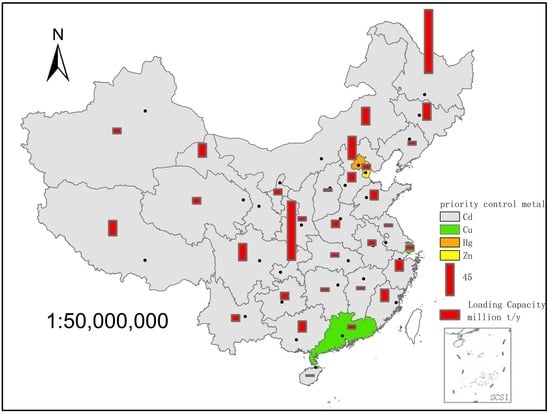Loading Capacity of Sewage Sludge for Forestry Application in Chinese Provincial Capital Cities
Abstract
1. Introduction
2. Methods
2.1. Data Preparation
2.2. Calculating the Loading Capacity of SS for Forestry Application
3. Results
3.1. Spatial Distribution of Metals in SS
3.2. Threshold of SS for Forestry Application, Sn
3.3. Loading Capacity of SS for Forestry Application
4. Discussion
5. Conclusions
Supplementary Materials
Author Contributions
Funding
Acknowledgments
Conflicts of Interest
References
- Yang, J.; Lei, M.; Chen, T.; Gao, D.; Zheng, G.; Guo, G.; Lee, D. Current status and developing trends of the contents of heavy metals in sewage sludges in China. Front. Environ. Sci. Eng. 2014, 5, 719–728. [Google Scholar] [CrossRef]
- Wang, M. Land application of sewage sludge in China. Sci. Total Environ. 1997, 197, 149–160. [Google Scholar] [CrossRef]
- Fytili, D.; Zabaniotou, A. Utilization of sewage sludge in EU application of old and new methods a review. Renew. Sustain. Energy Rev. 2008, 1, 116–140. [Google Scholar] [CrossRef]
- Larsen, T.A.; Hoffmann, S.; Luthi, C.; Truffer, B.; Maurer, M. Emerging solutions to the water challenges of an urbanizing world. Science 2016, 352, 928–933. [Google Scholar] [CrossRef]
- Wang, X.; Daigger, G.; Vries, M.; Ckroeze, C.; Yang, M.; Ren, N.; Liu, J.; Butler, D. Impact hotspots of reduced nutrient discharge shift across the globe with population and dietary changes. Nat. Commun. 2019, 10, 2627. [Google Scholar] [CrossRef] [PubMed]
- Ministry of Ecology and Environment of the People’s Republic of China. National Eco-Environment Bulletin; Ministry of Ecology and Environment of the People’s Republic of China: Beijing, China, 2017.
- Zhu, R.; Wu, M.; Yang, J. Mobilities and leachabilities of heavy metals in sludge with humus soil. J. Environ. Sci. 2011, 23, 247–254. [Google Scholar] [CrossRef]
- Ashraf, M.A.; Mahmood, K.; Yusoff, I.; Qureshi, A.K. Chemical constituents of cenchrus ciliaris L. from the cholistan desert, pakistan. Arch. Biol. Sci. 2013, 4, 1473–1478. [Google Scholar] [CrossRef]
- Kominko, H.; Gorazda, K.; Wzorek, Z. Potentiality of sewage sludge-based organo-mineral fertilizer production in poland considering nutrient value, heavy metal content and phytotoxicity for rapeseed crops. Environ. Res. 2019, 248, 109283. [Google Scholar] [CrossRef]
- Czyżyk, F.; Rajmund, A. Influence of agricultural utilization of sludge and compost from rural wastewater treatment plant on nitrogen passes in light soil. Pol. J. Chem. Technol. 2014, 1, 1–6. [Google Scholar] [CrossRef]
- Siebielec, G.; Siebielec, S.; Lipski, D. Long-term impact of sewage sludge, digestate and mineral fertilizers on plant yield and soil biological activity. J. Clean. Prod. 2018, 187, 372–379. [Google Scholar] [CrossRef]
- Mohamed, B.; Olivier, G.; François, G.; Laurence, A.H.; Bourgeade, P.; Badr, A.-S.; Lotfi, A. Sewage sludge as a soil amendment in a Larix decidua plantation: Effects on tree growth and floristic diversity. Sci. Total Environ. 2018, 621, 291–301. [Google Scholar] [CrossRef] [PubMed]
- Denaix, L.; Thomas-Chéry, A.L.; Balet, J.; Benbrahim, M.; Carnus, J.M. Effects of municipal sewage sludge application on soil and purple moor-grass (molinia caerulea) contamination by metals in a maritime pine forest. Water Air Soil Poll. 2011, 219, 239–249. [Google Scholar] [CrossRef]
- Roy, M.; Couillard, D. Metal leaching following sludge application to a deciduous forest soil. Water Res. 1998, 5, 1642–1652. [Google Scholar] [CrossRef]
- Khadhar, S.; Sdiri, A.; Chekirben, A.; Azouzi, R.; Charef, A. Integration of sequential extraction, chemical analysis and statistical tools for the availability risk assessment of heavy metals in sludge amended soils. Environ. Pollut. 2020, 263, 114543. [Google Scholar] [CrossRef]
- Moffat, A.J.; Matthews, R.W.; Hall, J.E. The effects of sewage sludge on growth and foliar and soil chemistry in pole-stage corsican pine at ringwood forest, dorset UK. Can. J. For. Res. 1991, 21, 902–909. [Google Scholar] [CrossRef]
- Sauvé, S.; Manna, S.; Turmel, M.C.; Roy, A.G.; Courchesne, F. Solid-solution partitioning of Cd, Cu, Ni, Pb, and Zn in the organic horizons of a forest soil. Environ. Sci. Technol. 2003, 22, 5191–5196. [Google Scholar] [CrossRef] [PubMed]
- Benbrahim, M.; Denaix, L.; Thomas, A.L.; Balet, J.; Carnus, J.M. Metal concentrations in edible mushrooms following municipal sludge application on forest land. Environ. Poll. 2006, 3, 847–854. [Google Scholar] [CrossRef] [PubMed]
- Rutgersson, C.; Ebmeyer, S.; Lassen, S.B.; Karkman, A.; Fick, J.; Kristiansson, K.; Brandt, K.K.; Flach, C.-F.; Larsson, D.G.J. Long-term application of swedish sewage sludge on farmland does not cause clear changes in the soil bacterial resistome. Environ. Int. 2020, 137, 105399. [Google Scholar] [CrossRef] [PubMed]
- Khadhar, S.; Higshi, T.; Hamdi, H.; Matsuyama, S.; Charef, A. Distribution of 16 EPA-priority polycyclic aromatic hydrocarbons (PAHs) in sludges collected from nine Tunisian wastewater treatment plants. J. Hazard. Mater. 2010, 183, 98–102. [Google Scholar] [CrossRef]
- Nogueira, T.A.R.; Melo, W.J.; Fonseca, I.M.; Marcussi, S.A.; Melo, G.M.P.; Marques, M.O. Fractionation of Zn, Cd and Pb in a tropical soil after nine-year sewage sludge applications. Pedosphere 2010, 20, 545–556. [Google Scholar] [CrossRef]
- Riaz, U.; Murtaza, G.; Saifullah, U.; Farooq, M. Influence of different sewage sludges and composts on growth, yield, and trace elements accumulation in rice and wheat. Land Degrad. Dev. 2018, 5, 1343–1352. [Google Scholar] [CrossRef]
- Bourioug, M.; Gimbert, F.; Alaoui-Sehmer, L.; Benbrahim, M.; Badot, P.M.; Alaoui-Sosse, B.; Aleva, L. Effects of sewage sludge amendment on snail growth and trace metal transfer in the soil-plant-snail food chain. Environ. Sci. Poll. Res. 2015, 22, 17925–17936. [Google Scholar] [CrossRef]
- Müller da Silva, P.H.; Poggiani, F.; Laclau, J.P. Applying sewage sludge to eucalyptus grandis plantations: Effects on biomass pro-duction and nutrient cycling through litterfall. Appl. Environ. Soil Sci. 2011, 1, 101–108. [Google Scholar]
- Zhang, T. Studies on the Sludge Application to Forest Land. Master’s Thesis, Northwestern Agricultural University, Shaanxi, China, 1992. [Google Scholar]
- Wang, X.; Chen, T.; Ge, Y.; Jia, Y. Studies on land application of sewage sludge and its limiting factors. J. Hazard Mater. 2008, 160, 554–558. [Google Scholar] [CrossRef]
- Wang, H.L.; Wang, C.J.; Fan, C.; Ma, M.P.; Lin, Z.K.; Wang, W.W.; Xu, Z.T.; Wang, X.D. Modification to degradation of hexazinone in forest soils amended with sewage sludge. J. Hazard. Mater. 2012, 199–200, 96–104. [Google Scholar] [CrossRef]
- Kacprzaka, M.; Neczaja, E.; Fijałkowskia, K.; Grobelaka, A.; Grossera, A.; Worwaga, M.; Rorata, A.; Brattebob, H.; Almåsc, A.; Singhc, B.R. Sewage sludge disposal strategies for sustainable development. Environ. Res. 2017, 156, 36–42. [Google Scholar] [CrossRef]
- Ministry of Environmental Protection. A National Survey of Soil Pollution Bulletin; Ministry of Environmental Protection: Beijing, China, 2014.
- Sterritt, R.M.; Lester, J.N. Concentrations of heavy metals in forty sewage sludges in England. Water Air. Soil. Poll. 1980, 1, 125–131. [Google Scholar] [CrossRef]
- Ou Yang, X.H.; Cui, J.; Tong, Q. Effects of long-term application of sewage sludge on soils and crops in agriculture. Agro-Environ. Prot. 1994, 13, 271–274. [Google Scholar]
- Li, Y.X.; Wang, M.J.; Wang, J.S. Heavy metals in contemporary Chinese sewage sludges. Toxicol. Environ. Chem. 1999, 1–2, 229–240. [Google Scholar] [CrossRef]
- Li, J.J. The Effect of Weathered Coal Activated by Ultrasonic on the Forms of Mercury in Soil and Soil Enzyme Activity; Shandong Agriculture University: Shandong, China, 2014. [Google Scholar]
- Zhang, X.X.; Zha, T.G.; Guo, X.P.; Meng, G.X.; Zhou, J.X. Spatial distribution of metal pollution of soils of Chinese provincial capital cities. Sci. Total Environ. 2018, 643, 1502–1513. [Google Scholar] [CrossRef]
- Steyn, C.E.; Herselman, J.E. Trace element concentrations in soils under different land uses in Mpumalanga province, South Africa, South African. J. Plant Soil. 2006, 4, 230–236. [Google Scholar]
- Contina, M.; Goib, D.; Nobility, M. Land application of aerobic sewage sludge does not impair methane oxidation rates of soils. Sci. Total Environ. 2012, 20, 10–18. [Google Scholar] [CrossRef] [PubMed]
- Ministry of Housing and Urban and Rural Construction in People’s Republic of China. Disposal of Sludge from Municipal Wastewater Treatment Plants-Quality of Sludge Used in Forestland (CJ/T 362-2011); Ministry of Housing and Urban and Rural Construction in People’s Republic of China: Beijing, China, 2011.
- Mcgrath, S.P.; Chang, A.C.; Pang, A.L.; Witter, E. Land application of sewage sludge: Scientific perspectives of heavy metal loading limits in Europe and the United States. Environ. Rev. 1994, 2, 108–118. [Google Scholar] [CrossRef]
- Ministry of Housing and Urban and Rural Construction in People’s Republic of China. Statistical Yearbook on Urban Construction; Ministry of Housing and Urban-Rural Construction of the People’s Republic of China: Beijing, China, 2017.
- Cheng, J.M. Study on Soil-Environmental Capacity in Main Soil-Types of Shandong Province; Shandong Normal University: Shandong, China, 2009. [Google Scholar]
- Yi, S.Z. Application of soil environment background values in calculation of soil capacity. Shanghai Environ. Sci. 1992, 4, 34–36. [Google Scholar]
- Yu, G.J.; Cheng, J.M.; Wang, Z.X.; Mu, J.B.; Jing, L.X. Soil-Environmental capacity in different vegetative types in Shandong province. Chin. J. Soil Sci. 2009, 2, 367–368. [Google Scholar]
- Ministry of Ecological Environment Protection of People’s Republic of China. Environmental Quality Standard for Soils Environmental Quality Standard for Soils (GB 15618–2018); Ministry of Housing and Urban-Rural Construction of the People’s Republic of China: Beijing, China, 2018.
- Environmental Engineering Assessment Center of State Environmental Protection Administration. Technical Methods of Environmental Impact Assessment; Environmental Science Press: Beijing, China, 2007. [Google Scholar]
- Ministry of Housing and Urban and Rural Construction in People’s Republic of China. Disposal of Sludge from Municipal Wastewater Treatment Plant-Quality of Sludge used in Garden or Park (GB23486-2009); Ministry of Housing and Urban-Rural Construction of the People’s Republic of China: Beijing, China, 2009.
- Oberg, G.; Mason-Renton, S.A. On the limitation of evidence-based policy: Regulatory narratives and land application of biosolids/sewage sludge in BC, Canada and Sweden. Environ. Sci. Policy 2018, 84, 88–96. [Google Scholar] [CrossRef]
- Kang, J.; Zheng, Z.Q. Status and prosper of sludge composting for urban greening. Energ. Conserve. Environ. Prot. 2007, 7, 33–34. [Google Scholar]
- Si, L.Q.; Chen, L.M.; Zheng, J.M.; Zhou, J.X.; Peng, X.W. Effects of mixed sewage sludge and garden waste composts on potting soil amendment. Pratacultural Sci. 2018, 1, 1–9. [Google Scholar]
- Wang, X.; Chen, T.; Jia, Y.F.; Ge, Y.H. Studies on land application of sewage sludge and its limiting factors. J. Hazard. Mater. 2008, 2, 554–558. [Google Scholar] [CrossRef]
- Duan, H.P.; Huang, J.M.; Cheng, W.Y. Application of sludge and garbage compost in highway slope greening. Highway 2008, 6, 204–207. [Google Scholar]
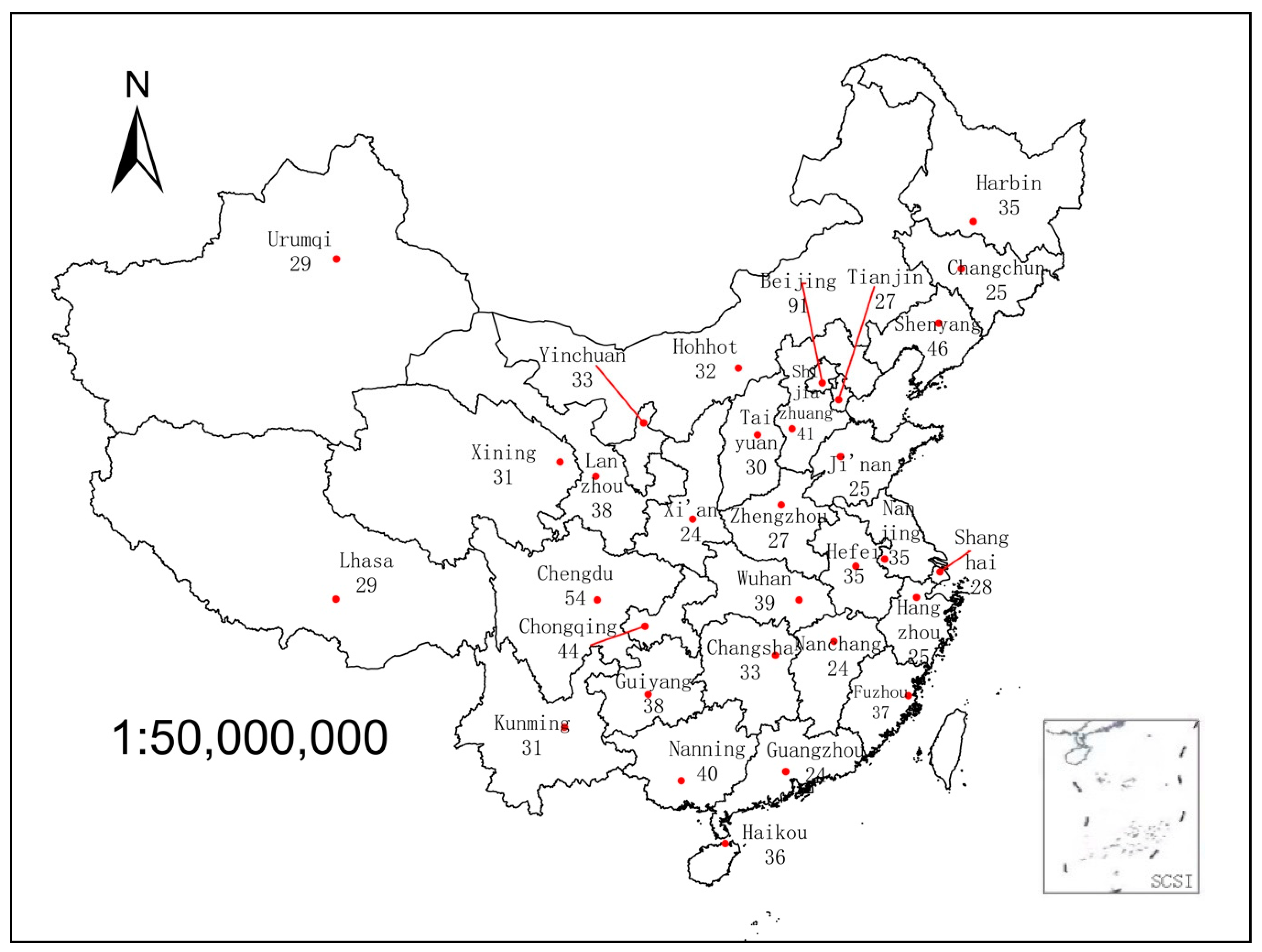
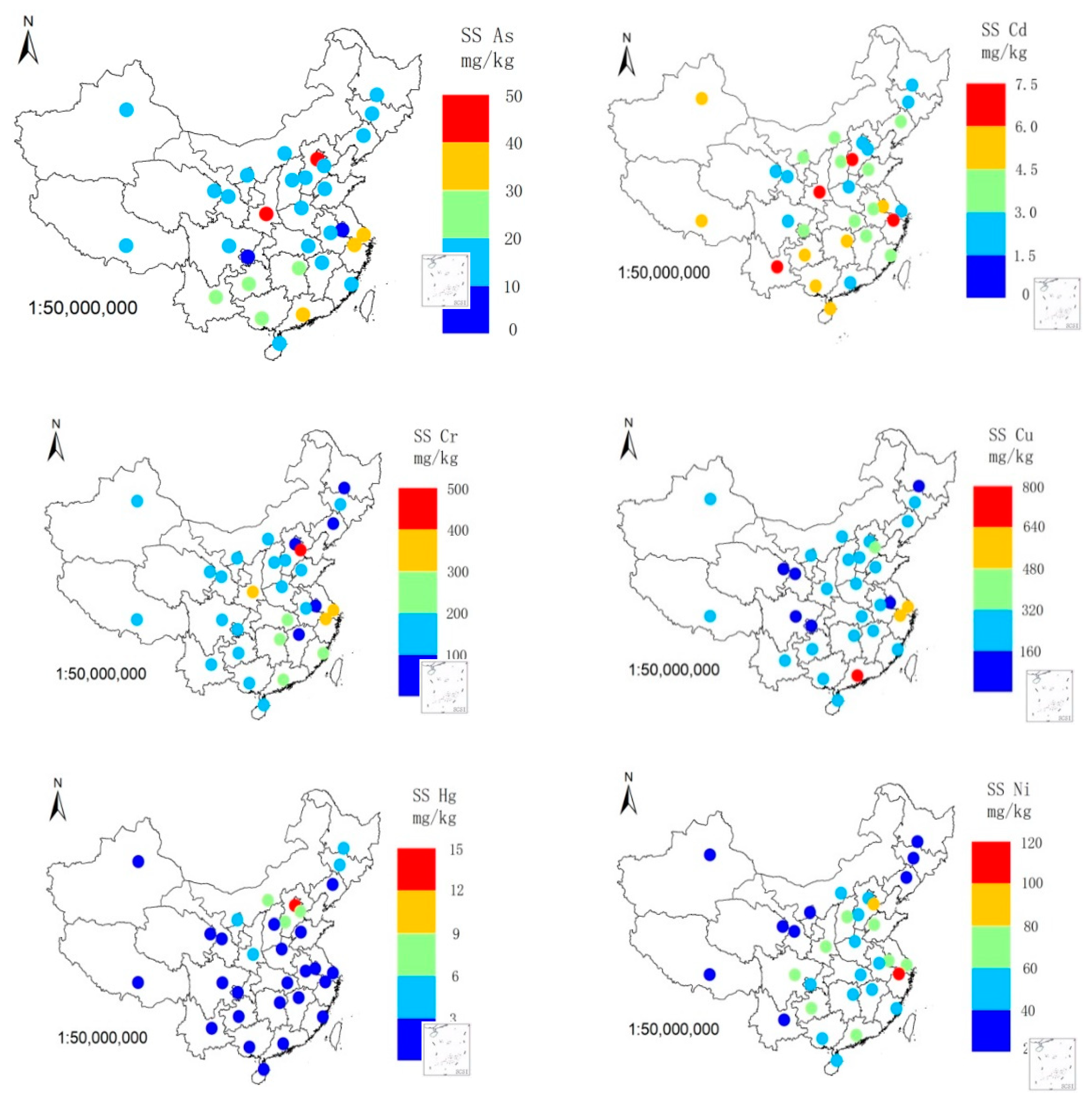

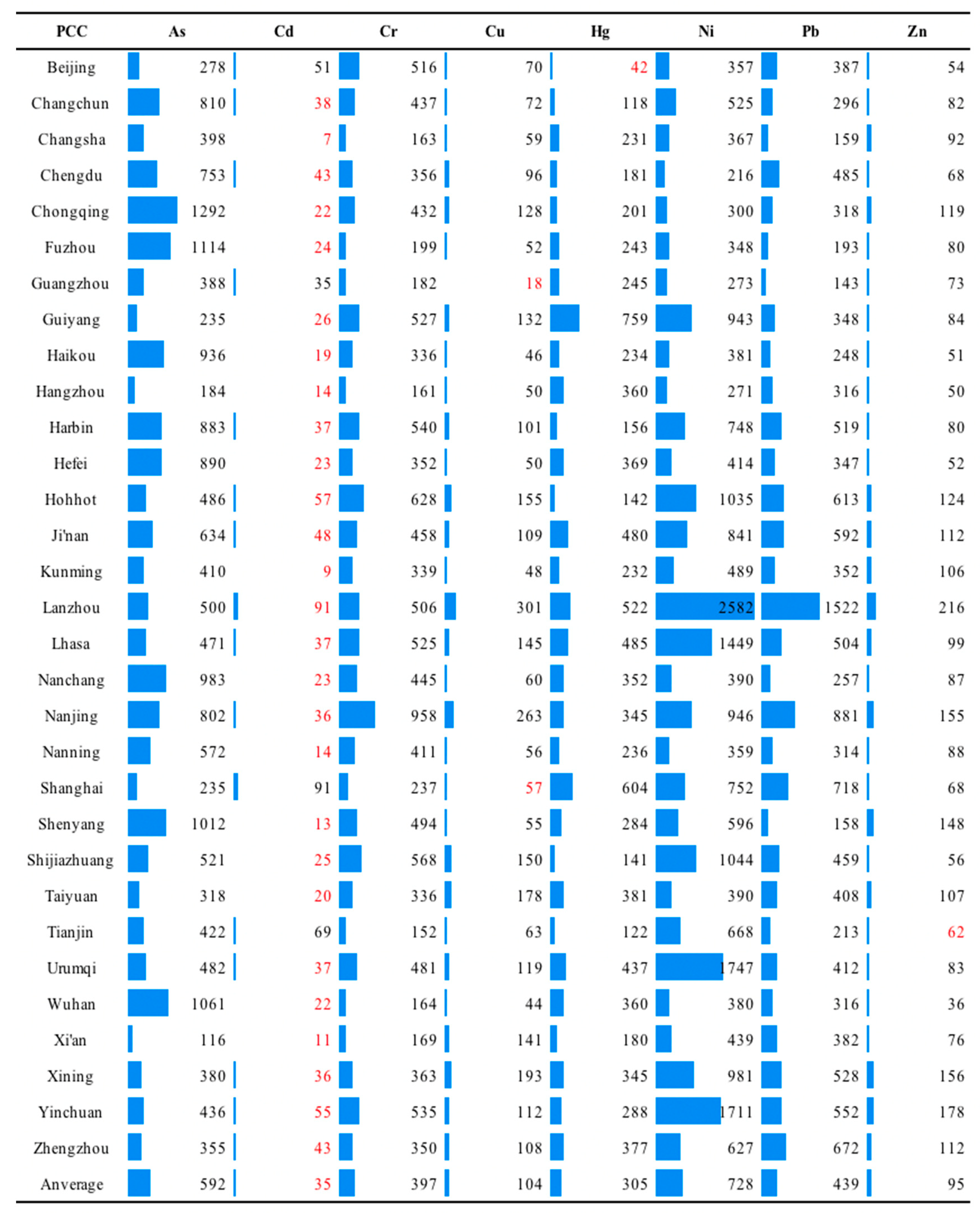
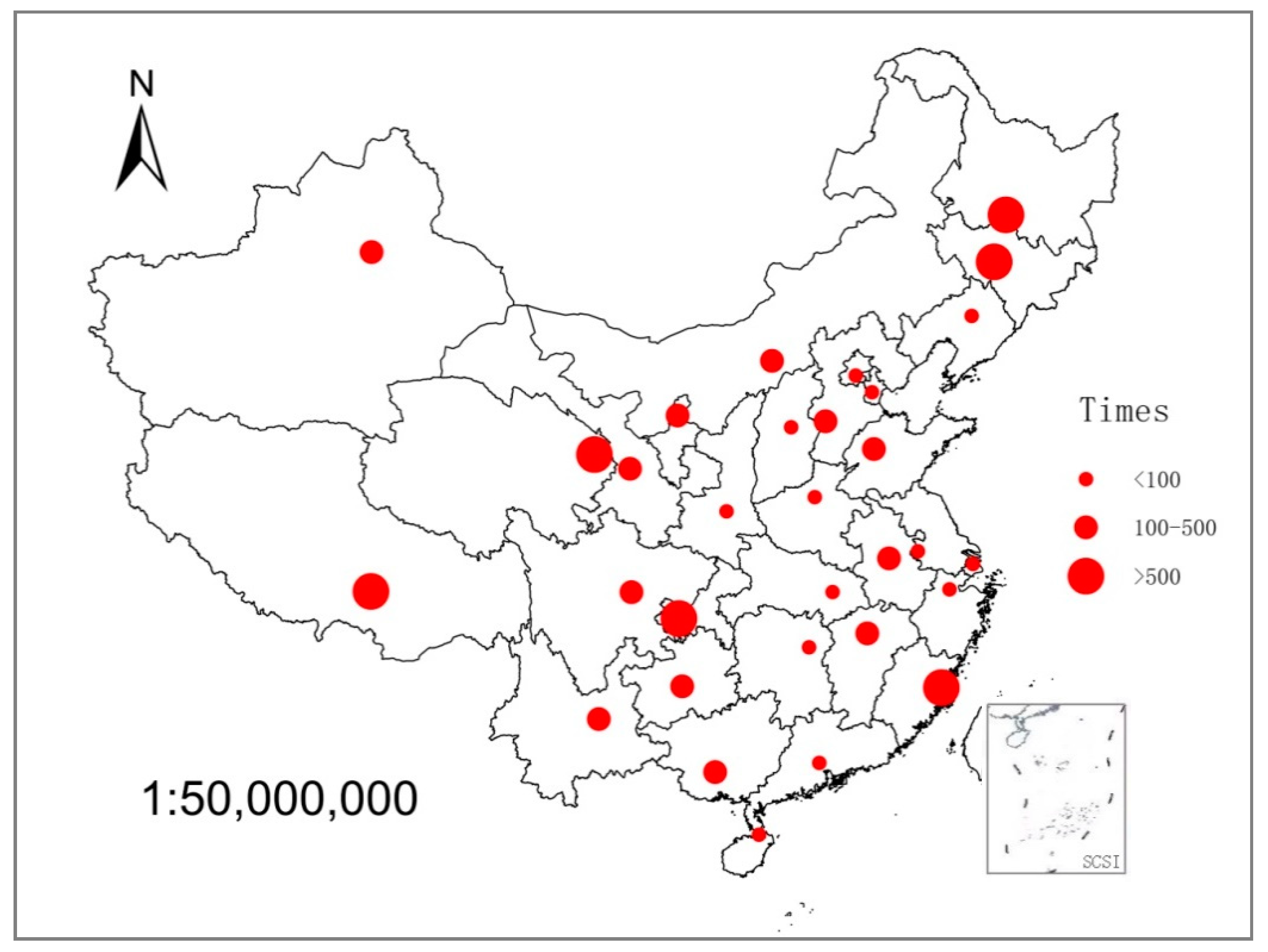
| Unit: mg·kg−1 | ||||||
|---|---|---|---|---|---|---|
| Metal | Risk Screening Values for Soil | Limits for SS | ||||
| pH ≤ 5.5 | 5.5 < pH ≤ 6.5 | 6.5 < pH ≤ 7.5 | pH > 7.5 | <6.5 | ≥6.5 | |
| As | 40 | 40 | 30 | 25 | 75 | 75 |
| Cd | 0.3 | 0.3 | 0.3 | 0.6 | 5 | 20 |
| Cr | 150 | 150 | 200 | 250 | 600 | 1000 |
| Cu | 50 | 50 | 100 | 100 | 800 | 1,00 |
| Hg | 1.3 | 1.8 | 2.4 | 3.4 | 5 | 15 |
| Ni | 60 | 70 | 100 | 190 | 100 | 200 |
| Pb | 70 | 90 | 120 | 170 | 300 | 1000 |
| Zn | 200 | 200 | 250 | 300 | 2000 | 4000 |
| PCC | Smin (t·ha−1·y−1) | Forest Area (104 ha) | Loading Capacity (Million t·y−1) |
|---|---|---|---|
| Harbin | 37 | 244 | 90.2 |
| Chongqing | 22 | 374 | 83.4 |
| Beijing | 42 | 76.8 | 32.5 |
| Hohhot | 57 | 43.2 | 24.8 |
| Changchun | 38 | 63.1 | 24.0 |
| Chengdu | 43 | 55.0 | 23.8 |
| Lasa | 37 | 57.6 | 21.5 |
| Lanzhou | 91 | 20.9 | 19.1 |
| Fuzhou | 24 | 72.4 | 17.5 |
| Hangzhou | 14 | 113 | 15.6 |
| Nanning | 14 | 106 | 15.3 |
| Ji’nan | 48 | 28.2 | 13.6 |
| Shijiazhuang | 25 | 51.6 | 13.0 |
| Zhengzhou | 43 | 23.7 | 10.2 |
| Guiyang | 26 | 39.3 | 10.1 |
| Kunming | 9 | 103 | 9.1 |
| Xining | 36 | 24.5 | 8.9 |
| Yinchuan | 55 | 14.4 | 8.0 |
| Hefei | 23 | 33.1 | 7.7 |
| Urumqi | 37 | 20.9 | 7.7 |
| Tianjin | 62 | 11.1 | 6.9 |
| Guangzhou | 18 | 31.5 | 5.8 |
| Xi’an | 11 | 48.5 | 5.5 |
| Wuhan | 22 | 24.0 | 5.3 |
| Shenyang | 13 | 39.9 | 5.1 |
| Changsha | 7 | 64.8 | 4.6 |
| Shanghai | 41 | 10.3 | 4.2 |
| Nanchang | 23 | 16.9 | 3.9 |
| Nanjing | 36 | 10.3 | 3.7 |
| Taiyuan | 20 | 16.1 | 3.2 |
| Haikou | 19 | 8.8 | 1.6 |
© 2020 by the authors. Licensee MDPI, Basel, Switzerland. This article is an open access article distributed under the terms and conditions of the Creative Commons Attribution (CC BY) license (http://creativecommons.org/licenses/by/4.0/).
Share and Cite
Zhang, X.; Zha, T.; Zhu, J.; Guo, X.; Liu, Y. Loading Capacity of Sewage Sludge for Forestry Application in Chinese Provincial Capital Cities. Sustainability 2020, 12, 7551. https://doi.org/10.3390/su12187551
Zhang X, Zha T, Zhu J, Guo X, Liu Y. Loading Capacity of Sewage Sludge for Forestry Application in Chinese Provincial Capital Cities. Sustainability. 2020; 12(18):7551. https://doi.org/10.3390/su12187551
Chicago/Turabian StyleZhang, Xiaoxia, Tonggang Zha, Jiangang Zhu, Xiaoping Guo, and Yi Liu. 2020. "Loading Capacity of Sewage Sludge for Forestry Application in Chinese Provincial Capital Cities" Sustainability 12, no. 18: 7551. https://doi.org/10.3390/su12187551
APA StyleZhang, X., Zha, T., Zhu, J., Guo, X., & Liu, Y. (2020). Loading Capacity of Sewage Sludge for Forestry Application in Chinese Provincial Capital Cities. Sustainability, 12(18), 7551. https://doi.org/10.3390/su12187551



